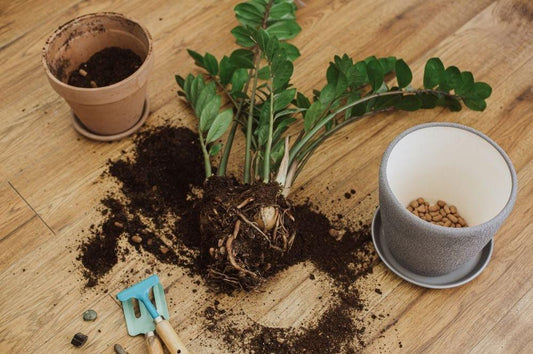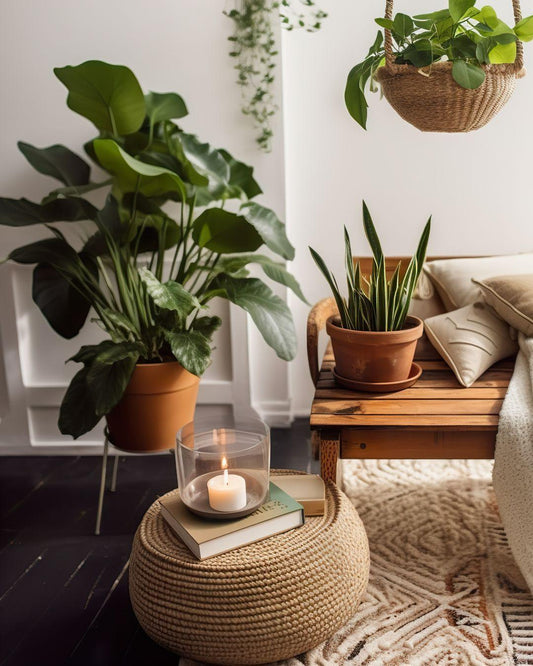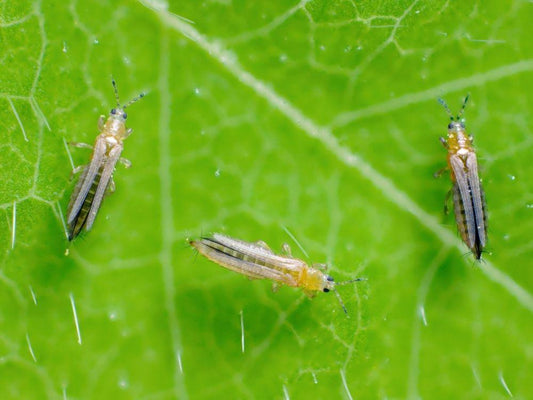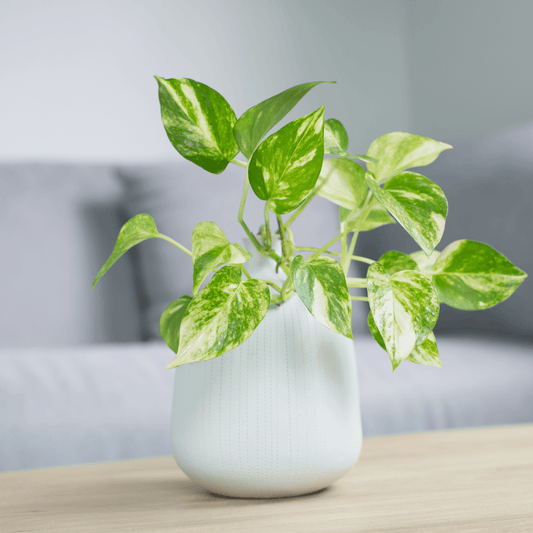Zamioculcas Zamiifolia, also known as Zanzibar Gem or ZZ Plant, has become increasingly popular due to its beauty and ease of care.
In this comprehensive guide we will explore everything you need to know about growing, caring for and top tips to help your Zamioculcas thrive.

This plant has been introduced as a houseplant in recent decades, but has become particularly popular in recent years due to its hardiness and ability to survive low light and neglect. Zamioculcas was initially grown as an ornamental houseplant in homes and offices, due to its glossy, leathery leaves, easy care, and ability to adapt to a wide range of environmental conditions.
Habitat and Origins: Journey to the Tropical Lands of East Africa
Before we dive into the details of Zamioculcas care, it is essential to understand its origins and natural habitat.
Zamioculcas, commonly known as ZZ or Zanzibar Gem, It is native to tropical regions of East Africa, such as Tanzania, Kenya and Zanzibar . Although it is considered a houseplant and can be grown successfully in temperate climates, it is native to tropical habitats and grows naturally in similar conditions.
In these regions, the plant thrives in habitat rich in humidity And diffused light , often grows under tree cover in the rainforests , in humus-rich soils .
The relative humidity in the natural habitat of Zamioculcas varies according to the season and the specific conditions of the environment. In general, in the rainforests of East Africa, humidity can be considerable, especially during the rainy season. However, it is important to note that Zamioculcas is a plant that can tolerate a range of humidity conditions, including relatively low ones. When growing Zamioculcas indoors, it is often not necessary to maintain particularly high humidity levels, as the plant can also adapt well to environments with moderate or even low humidity.
Characteristics of Zamioculcas

🌵 Succulent plant: It is a succulent plant of the Araceae family , and like other succulent plants it has fleshy leaves in which, together with the rhizomes, it stores water. We can therefore offer it a soil for succulent plants and we must moderate the watering, otherwise the roots will rot.
🌿 Shiny Leaves: It has shiny, leathery leaves that add a touch of elegance and freshness to any indoor environment.
🌒 Low light tolerance: Zamioculcas is known for its ability to tolerate low light conditions, making it ideal for interiors with little natural light. However, if we can provide it with more light, we will see it thrive and perhaps if we are lucky we may even see it flower.
💪🏼 Resilience: This plant is remarkably hardy and low maintenance, making it perfect for those who are new to houseplants or have busy lifestyles.
🏜️ Drought Survival: Like Sansevieria, Zamioculcas is a hardy and robust plant, able to survive even with little care and in drought conditions. It is perfect for those who do not have a green thumb or who forget to water their plants. Thanks to the ability to store water in its rhizomes, Zamioculcas can withstand prolonged periods without water.
🧳 Adaptability: Zamioculcas is able to adapt to a variety of environmental conditions and is particularly suitable for indoor cultivation. It is an excellent choice for any type of home or work environment.
🐌 Slow growth: Zamioculcas is a slow grower, which means it requires little care and will not quickly outgrow its container. This makes it perfect for those who want a slow growing plant that requires little maintenance.
🫧 Air Purifier: Like many other houseplants, Zamioculcas is also able to purify the air, helping to remove harmful substances and improving the air quality in the home.
Placement in the Home: Light and Temperature
To ensure optimal growth of Zamioculcas, it is important to position it correctly in the home, considering both exposure to light and room temperature. Here are some points to consider:
🔆 Diffused light: Zamioculcas prefers indirect or filtered light, avoiding direct exposure to intense sunlight that could burn the leaves. Place it in an area of the house where it receives diffused light, such as near a window facing north or east. This plant also adapts to rooms with reduced light.
🌡️ Temperature: Zamioculcas thrives in moderate temperature conditions. It is suited to temperatures between 18°C and 24°C during the day, while it prefers slightly cooler temperatures at night, around 16°C and 18°C.
😶🌫️ Humidity: Zamioculcas does not require particularly high humidity levels and can tolerate moderate or even low humidity conditions. However, if the air in your home is particularly dry, it may be helpful to slightly increase the humidity around the plant, for example by using a humidifier or by misting the leaves with water from time to time.
💨 Avoid drafts: Make sure to place your Zamioculcas in an area of your home where it is not subject to drafts, which could damage the leaves and compromise its overall health.
By placing the Zamioculcas in an environment with diffused light, moderate temperature and protecting it from drafts, you will encourage healthy and vigorous growth of the plant, allowing it to fully express its tropical beauty within your home environment.
Watering
Zamioculcas requires specific care regarding watering, since its water needs can vary with the changing seasons. The basic rule is to wait for the soil to dry between one watering and the next to avoid stagnation, root rot and consequently the death of the plant.
Zamioculcas has a characteristic that it shares with succulents, especially succulent plants: the ability to withstand long periods of drought. This means that it is able to store water in its rhizomes, allowing it to survive without water for extended periods. This adaptation gives it a greater tolerance to drought than other houseplants, making it an ideal choice for those looking for resilient and easy-to-care-for plants.
☀️ During the warmer and brighter months , the plant tends to be more active in growth and requires a greater quantity of water. In this phase, it is advisable to water the Zamioculcas regularly at least once a week and maximum 2 times. Checking the humidity of the soil before each watering is essential to avoid water stagnation.
❄️ With the arrival of the colder months and shorter days, Zamioculcas reduces its metabolic activity and growth. During this phase, it is important to gradually reduce the frequency of watering, allowing the soil to dry slightly between waterings. This helps prevent water stagnation and root rot, common problems during the winter months. As a guide, we can water it 1 to 3 times a month, but this is not a rule as it depends on many factors such as the temperature of the house and the humidity of the air.
So regardless of the season, the fundamental rule is to water the Zamioculcas only when the soil is very dry.
Furthermore, since Zamioculcas is native to the tropical regions of East Africa, where dry seasons with less rainfall occur, the plant is adapted to periods of reduced water availability. In nature, during the dry season, the plant can survive with less water, adapting its metabolism and water needs to environmental conditions.
In general, it is therefore advisable to carefully observe the Zamioculcas and adjust watering according to its seasonal needs.
Humidity
When it comes to providing the right humidity in the home, Zamioculcas prefers an environment with moderate humidity.
In general, our homes tend to have low humidity, especially during the winter months due to internal heating.
To maintain proper humidity levels around the plant, there are several strategies that can be used. For example, placing the Zamioculcas on a tray filled with water and gravel can help increase humidity in the surrounding area through evaporation. Alternatively, using a humidifier in your home can help maintain optimal humidity levels for Zamioculcas and other plants.
Another effective method to increase humidity around Zamioculcas, which I personally use with success, is to spray non-calcareous water directly on the foliage of the plant. This helps to keep the foliage hydrated and can help balance the humidity in the surrounding environment.
Substrate Type: Good drainage for healthy roots
Choosing the right substrate is essential for the health and well-being of Zamioculcas. A high-quality substrate provides the necessary support for the roots and promotes proper growth of the plant.
It is advisable to use a well-draining substrate that allows excess water to drain quickly, avoiding stagnation that can lead to root rot. An ideal mix might include a combination of peat moss, perlite, and sand, which provides good drainage and aeration for the roots, while retaining adequate moisture to support the plant's growth.
The best choices are two: use a good quality specific soil for green plants (which is used for tropical plants) and mix it with other useful materials for better aeration and drainage or opt for a soil for succulent plants.
Choice of Vase
Choosing the right pot is crucial for Zamioculcas.
It is advisable to choose a pot with a good drainage system, so that excess water can drain freely, avoiding stagnation that could damage the plant's roots.
Terracotta pots are the best choice for Zamioculcas. Terracotta is a porous material that allows for good air circulation and promotes drainage of excess water, helping to prevent waterlogging and root rot. Terracotta pots are also durable and stable, making them ideal for supporting the plant's growth over time.
However, you can also choose high-quality ceramic or plastic pots, as long as they have a good drainage system and fit your style and the aesthetic needs of your space. The essential thing is that they are perforated at the bottom.
The roots of Zamioculcas like to stay in a narrow space and it is usually repotted when the roots no longer fit into the pot to the point of deforming or even breaking it.
When repotting, choose a pot that is slightly larger than the current root system. It is important that the new pot is slightly larger than the previous one; this will allow the plant to grow further but at the same time not to have excess water in the soil that would cause root rot.
Zamioculcas is a relatively slow grower so you will need to repot it approximately every 2 or 3 years.
Fertilization
Fertilize Zamioculcas during the active growing season, using a balanced, complete fertilizer formulated specifically for houseplants or tropical plants.
Choose a liquid or granular fertilizer with a balanced ratio of nutrients such as nitrogen, phosphorus and potassium, along with essential microelements such as iron, magnesium and zinc.
You can apply the fertilizer during the plant's active growing season, usually from spring to summer, diluting it according to the instructions on the package and applying it regularly every 2-4 weeks. It is important not to overdo the fertilizer, as excessive use can damage the plant's roots.
Propagation Methods: Multiply Your Plant

Zamioculcas can be propagated by several methods, including:
- Separation of plant parts: This method involves dividing the mother plant into several parts, each of which has well-developed roots and shoots. This is an effective method for obtaining new plants identical to the mother plant.
- Suckers: Zamioculcas can produce suckers, which are small shoots that emerge from the base of the mother plant. These suckers can be separated from the mother plant and transplanted independently to create new plants.
- Cutting: Cutting involves cutting a portion of a healthy stem or stalk from the mother plant and rooting it in moist, well-drained soil. After a while, the cutting should develop roots of its own and grow as a new, independent plant.
- Leaf cutting: In this method, a single healthy leaf is cut from the mother plant and placed in a moist substrate. Over time, the leaf should produce roots and give rise to a new plant. This method is less common than the others, but can still be effective for propagating Zamioculcas.
Regardless of the method chosen, it is important to use clean, sharp tools to avoid damaging the mother plant and ensure successful propagation. Also, make sure that the young plants are placed in a warm, humid environment to encourage root development.
Conclusion
Zamioculcas is an extraordinary plant that adds elegance and freshness to any indoor environment. With the right care and attention, it can become an iconic feature of your home.
Explore my other one too ViolVaio blog to discover other curiosities about plants, especially tropical plants and the products I recommend for their care and cultivation.
Read also the article on dieffenbachia, where the products I recommend such as soils and aggregates, pots, rooting agents and fertilizers, are valid for all tropical plants! Read the article





